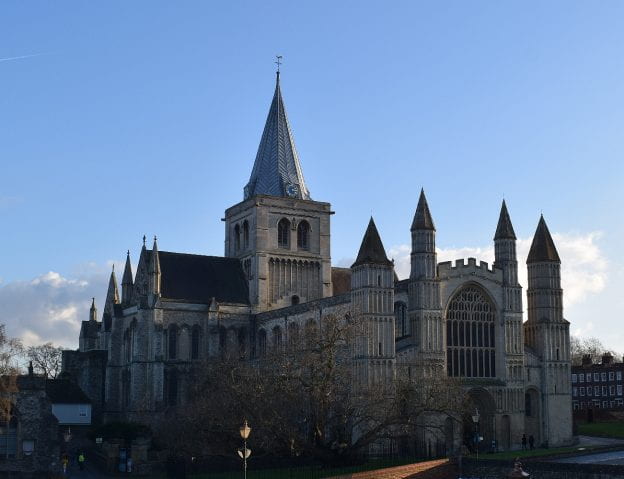(CW miscarriage)
It seems quite a long time since I looked at this one in TNA in Kew – on a nice foray in summer 2022. I just found it when sorting through some papers for a big clear-out, and it seems a shame not to put it ‘out there’, with a few comments. I can’t see when I am going to be able to write it up properly, so, for what it’s worth, here goes …
C1/14/44 has a catalogue reference which dates it to 1443-50.[i] This states that Richard, bishop of Rochester, (probably not really a Richard – see further below) examined on oath in the Chancery, said that whereas Reginald Pekham of Kent, esquire, had claimed that there had been some dispute with the men of the Archbishop of Canterbury[ii], and his (Reginald’s) wife, children, servants and familia had been attacked at Ightham, Kent,[iii] by men and servants of, Sibill, daughter of Reginald and wife of Richard Culpeper esquire, who, at the time of the said attack was pregnant,[iv] within a short time after this, gave birth to an ‘abortive foetus’,[v] [in fact] the Bishop, together with John Bamburgh & lady Elizabeth Culpeper, wife of Hugh Godewyne, at Wrotham, baptised[vi] the infant Sibill had borne, naming him Richard, and, after being born,[vii] the infant lived[viii] for about a year.[ix]
The context of the document is unknown. Such an inquiry might indicate some sort of attempt to discredit the bishop of Rochester: if he had indeed baptised a miscarried foetus, this would clearly be very bad practice. There are other possibilities though. It might be something which was produced in the context of a contested claim to tenancy by the curtesy. We can imagine a dispute in which Reginald was trying to say that the attack at Aldham had had dire consequences, including the death of this potential grandchild, and somebody else was trying to minimise that, and dissociate the death from the attack. Moving the two a year apart would do that effectively. Another possible context would be a claim by Richard Culpeper to tenancy by the curtesy of Sibilla’s family lands, if and when she predeceased him: to qualify for a life interest of this sort, a man had to have produced live, legitimate, issue. Again, it would be useful to be able to have evidence of a baptism by a high-ranking churchman, to support such a claim. Using the father’s name for the child’s christening adds that extra bit of dynastic connection, and perhaps suggests that this was the heir presumptive.[x] The possible snag with this theory was Kent’s special land law, which included different rules for curtesy, and did not require the birth of live offspring – so this would not work for gavelkind lands.
I find myself asking, in a less legally-focused way, if it was plausible that there was a child which had lived for a year, what does that say about the nature of the relationships expected between a grandfather and grandchild in the same county? I am also at a bit of a loss to come up with any reason why Bishop Richard would lie about the child’s survival (unless he had, in fact, participated in a dodgy baptism of the not-alive).
Just possibly, there may be more evidence to find on all that, but it might be a while before I get to it.
GS
30/3/2024
[i] The catalogue entry includes ‘stillbirth’, and that is what drew me to it at first: that particular term is an interesting one in the present day, contrasting in its nuances with the ‘born dead’ terms ubiquitous in other languages, and, I am keen to trace its origins. Anyway, the document itself does not use the term ‘stillbirth’, but it is very interesting in other ways.
[ii] ‘The Venerable father John Archbishop of Canterbury, Chancellor of the Lord King’. This would presumably be John Stafford, if the catalogue date is right – though there was not a Richard as bishop of Rochester at that point. However, if Bishop Richard is Richard Young, 1404-18, then there was not a John as Archbishop of Canterbury/Chancellor at that point – a puzzle, and clearly some mistake somewhere! A copying mistake, influenced by all of the other Richards, perhaps? There was a prior of Rochester called Richard in the 1460s, but that probably doesn’t work…
[iii] ‘Aldham’
[iv] There is language of ‘supposition’ and ‘claim’ here, but this is not a case in which it is suggested that there was a false claim of pregnancy, so this must be associated with Reginald’s narrative.
[v] (fetum peperit abortiuum)
[vi] (lifted from the holy font)
[vii] (post partum suum)
[viii] (vitam duxit in humanis)
[ix] There is nothing on the dorse
[x] We will not get into lurid speculation about Bishop Richard’s involvement being more than just doing the honours at the baptism!
Image: Rochester Cathedral – isn’t it lovely! I have never been – one more for the bucket list.
